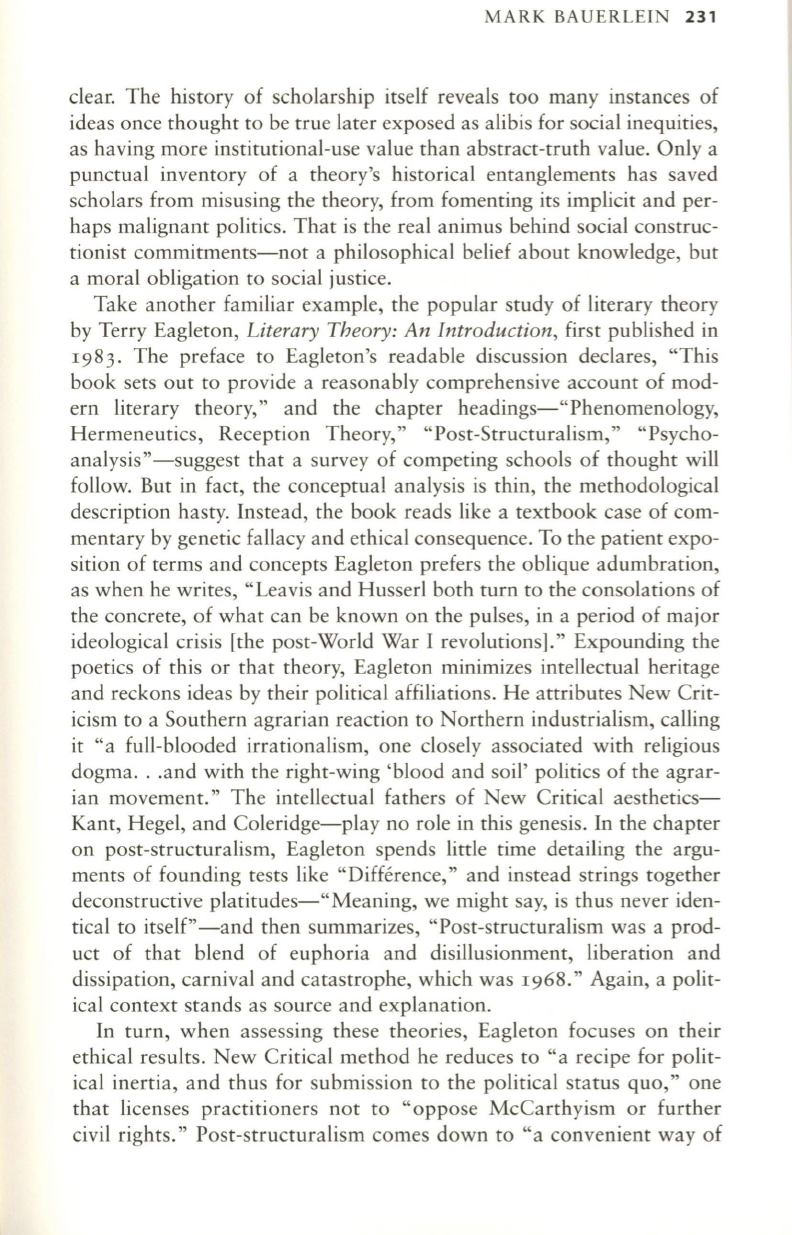
MARK BAUERLEIN
231
clear. The history of scholarship itself reveals too many instances of
ideas once thought to be true later exposed as alibis for social inequities,
as having more institutional-use value than abstract-truth value. Only a
punctual inventory of a theory'S historical entanglements has saved
scholars from misusing the theory, from fomenting its implicit and per–
haps malignant politics. That is the real animus behind social construc–
tionist commitments-not a philosophical belief about knowledge, but
a moral obligation to social justice.
Take another familiar example, the popular study of literary theory
by Terry Eagleton,
Literary Theory: An Introduction,
first published in
1983.
The preface to Eagleton's readable discussion declares, "This
book sets out to provide a reasonably comprehensive account of mod–
ern literary theory," and the chapter headings-"Phenomenology,
Hermeneutics, Reception Theory," "Post-Structuralism," "Psycho–
analysis"-suggest that a survey of competing schools of thought will
follow. But in fact, the conceptual analysis is thin, the methodological
description hasty. Instead, the book reads like a textbook case of com–
mentary by genetic fallacy and ethical consequence. To the patient expo–
sition of terms and concepts Eagleton prefers the oblique adumbration,
as when he writes, "Leavis and Husserl both turn to the consolations of
the concrete, of what can be known on the pulses, in a period of major
ideological crisis [the post-World War I revolutions]." Expounding the
poetics of this or that theory, Eagleton minimizes intellectual heritage
and reckons ideas by their political affiliations. He attributes New Crit–
icism to a Southern agrarian reaction to Northern industrialism, calling
it "a full-blooded irrationalism, one closely associated with religious
dogma ...and with the right-wing 'blood and soil' politics of the agrar–
ian movement." The intellectual fathers of New Critical aesthetics–
Kant, Hegel, and Coleridge-play no role in this genesis. In the chapter
on post-structuralism, Eagleton spends little time detailing the argu–
ments of founding tests like "Difference," and instead strings together
deconstructive platitudes-"Meaning, we might say, is thus never iden–
tical to itself"-and then summarizes, "Post-structuralism was a prod–
uct of that blend of euphoria and disillusionment, liberation and
dissipation, carnival and catastrophe, which was
1968."
Again, a polit–
ical context stands as source and explanation.
In turn, when assessing these theories, Eagleton focuses on their
ethical results. New Critical method he reduces to "a recipe for polit–
ical inertia, and thus for submission to the political status quo," one
that licenses practitioners not to "oppose McCarthyism or further
civil rights." Post-structuralism comes down to "a convenient way of


